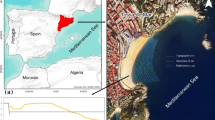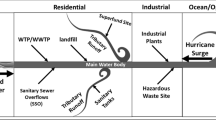Abstract
The accurate forecast from Hurricane Sandy sea surge was the result of integrating the most sophisticated environmental monitoring technology available. This stands in contrast to the limited information and technology that exists at the community level to translate these forecasts into flood hazard levels on the ground at scales that are meaningful to property owners. Appropriately scaled maps with high levels of certainty can be effectively used to convey exposure to flood hazard at the community level. This paper explores the most basic analysis and data required to generate a relatively accurate flood hazard map to convey inundation risk due to sea surge. A Boolean overlay analysis of four input layers: elevation and slope derived from LiDAR data and distances from streams and catch basins derived from aerial photography and field reconnaissance were used to create a spatial model that explained 55 % of the extent and depth of the flood during Hurricane Sandy. When a ponding layer was added to the previous model to account for depressions that would fill and spill over to nearby areas, the new model explained almost 70 % of the extent and depth of the flood. The study concludes that fairly accurate maps can be created with readily available information and that it is possible to infer a great deal about risk of inundation at the property level, from flood hazard maps. The study goes on to conclude that local communities are encouraged to prepare for disasters, but in reality because of the existing Federal emergency management framework there is very little incentive to do so.




Similar content being viewed by others
References
Akin S, O’Brien R (2012) Moonachie, Little Ferry work on recovery. The Record. NJ, 31 Oct 2012
Apel H, Aronica GT, Kreibich H, Thieken AH (2009) Flood risk analyses—How detailed we need to be? J Nat Hazards 49(79):98
ArcGIS 10.22, ESRI, 2013 380 New York Street, Redlands, CA
Bates PD, De Roo APJ (2000) A simple raster-based model for flood inundation simulation. J Hydrol 236:54–77
Blake ES, Kimberlain TB, Berg RJ, Cangialosi JP, Beven II JL (2013) Tropical Cyclone Report Hurricane Sandy (AL182012) 22–29 October 2012. NOAA, National Hurricane Center
Boburg S (2013) At Moonachie trailer park, Sandy aid, and recovery are lagging behind. http://www.northjersey.com/news/nj-state-news/at-moonachie-trailer-park-sandy-aid-recovery-are-lagging-behind-1.596014
Bode L, Hardy TA (1997) Progress and recent developments in storm surge modeling. J Hydraul Eng 123(4):315–331
Brown JD, Spencer T, Moeller Iris (2007) Modeling storm surge flooding of an urban area with particular reference to modeling uncertainties: a case study of Canvey Island, United Kingdom. Water Resour Res 43(6):W06402 (1–22)
Büchele B, Kreibich H, Kron A, Thieken A, Ihringer J, Oberle P, Merz B, Nestman F (2006) Flood risk mapping: contribution towards an enhanced assessment of extreme events and associated risks. Nat Hazards Earth Syst Sci 6:485–503
Chun SA, Artigas Fr (2012) Sensors and crowdsourcing for environmental awareness and emergency planning. Int J E-Plan Res (IJEPR) 1(1):56–74
Collins MG, Steiner FR, Rushmann MJ (2001) Land suitability in the United Sates: historical developments and promising technological achievements. Environ Manag 28(5):611–621
Cova TJ (1999) GIS in emergency management. In: Longley PA, Goodchild MF, Maguire DJ, Rhind DW (eds) Geographical information systems. Wiley, New York
David M (2009) The role of GIS. In: Fortheringham AS, Rogerson PA (eds) The sage handbook of spatial analysis. Sage Publication, Thousand Oaks
Dymon UJ (1990) The role of emergency mapping in disaster response. Quick Response Research Report #42. Colorado, Natural Hazards Research and Applications Information Center
FEMA (2013) The Stafford Act. Disaster relief and emergency assistance act. Public Law 93-288, as amended, 42 U.S.C. 5121 et seq
Fernández DS, Lutz MA (2010) Urban flood hazard zoning in Tucumán Province, Argentina, using multicriteria decision analysis. Eng Geol 111:90–98
Fotheringham AS, Rogerson PA (2009) The SAGE Handbook of Spatial Analysis. SAGE Publications, London, England
Garnet K, Lickorish FA, Rocks SA, Prpich G, Rathe AA, Pollard SJT (2016) Integrating horizon scanning and strategic risk prioritization using a weight of evidence framework to inform policy decision. Sci Total Environ 560–561:82–91
Georgas N, Horton P, Bloomberg A, Cohen L, Zarrilli D, Yin JL (2014) The impact of tidal phase on Hurricane Sandy’s flooding around New York City and Long Island. Extreme Events 1:1
Hagemeier-Klose M, Wagner K (2009) Evaluation of Flood Hazard Maps as Informatino Tools In Flood Risk Communications. Nat Hazards Earth Syst Sci 9:563–574
Hsu MH, Chen SH, Chang TJ (2000) Inundation simulation for urban drainage basin with storm sewer system. J Hydrol 234:21–37
IPCC (2013) Climate change 2014. Synthesis report summary for policy makers. http://www.ipcc.ch/publications_and_data/publications_and_data.shtml
Malczewski J (2014) GIS-based land-use suitability analysis: a critical overview. Prog Plan 62(1):3–65
MERI (2013) Municipal map assistance program, metadata directory. http://apps.njmeadowlands.gov/mapping/metadata/?c=municipal
Mileti D (1999) Disaster by design: a reassessment of natural hazards in the United States. Joseph Henry Press, Washington, DC
MOTF (2013) Hurricane Sandy impact analysis. FEMA, modeling task force. http://www.arcgis.com/home/item.html?id=307dd522499d4a44a33d7296a5da5ea0
National Research Council (2014) Reducing coastal risks on the east and gulf coasts. National Research Council of the national academies. The National Academies Press, Washington, DC
Neal JC, Bates PD, Fewtrell TJ, Hunter NM, Wilson MD, Horritt MS (2009) Distributed whole city water level measurements from the Carlisle 2005 urban flood event and comparison with hydraulic model simulations. J Hydrol 368(1–4):42–55
New Jersey Meadowlands Commission (2002) New Jersey Meadowlands Data Book
NOAA (2012) National Hurricane Center: Hurricane Sandy Advisory Archive. National Weather Service. http://www.nhc.noaa.gov/archive/2012/SANDY.shtml
O’Dea C (2013) Interactive map: assessing damage from superstorm sandy. NJ Spotlight. 15 March 2013
Quantum Spatial (2014) Hackensack Meadowlands, New Jersey. LiDAR Report of Survey Methods and Results. Corvallis, OR, USA
Resio TD, Westerink JJ (2008) Modeling the physics of storm surges. American Institute of Physics. Physics Today. WWW.physicstoday.org
Rossiter JR (1954) North-Sea storm surge of 31 January and 1 February 1953. Philos Trans R Soc Ser A 246(915):317–400
Saul MH (2012) Mayor Michael Bloomberg on Sunday ordered the evacuation of 375,000 people from low-lying areas in New York City in anticipation of Hurricane Sandy, signifying officials’ growing concern about the severity of the storm and its impact on the five boroughs. Wall Str J, 28 October 2012
Shin JY, Artigas F, Hobble C, Lee Y-S (2013) Assessment of anthropogenic influences on surface water quality in urban estuary, northern New Jersey: multivariate approach. Environ Monit Assess 185(3):2777–2794
Sopkin KL, Stockdon HF, Doran KS, Plant NG, Morgan KLM, Guy KK, Smith KEL (2014) Hurricane Sandy—observations and analysis of coastal change: U.S. Geological Survey Open-File Report 2014–1088, p 54
SPSS Statistics Base 20.0, IBM, Armonk, New York, NY, 2011
Sweet W, Zervas C, Gill S, Park J (2013) Hurricane Sandy inundation probabilities today and tomorrow. Bull Am Meteorol Soc 949:S17–S20
Tehrany MS, Pradhan B, Jebur MN (2014) Flood susceptibility mapping using novel ensemble weights-of-evidence and support vector machine models in GIS. J Hydrol 512:332–343
Tsakiris G (2014) Flood risk assessment: concepts, modelling, applications. Nat Hazards Earth Syst Sci 14:1361–1369
Zhu A-X (2009) Spatial scale and neighborhood size in spatial data processing for modeling the natural environment. In: Mount N, Harvey G, Priestnall G (eds) Representing modeling, and visualizing the natural environment Innovations in GIS. CRC Press, Boca Raton
Zhu Z, Chen Z, Chen X, He P (2016) Approach for evaluating inundation risk in urban drainage systems. Sci Total Environ 553:1–12
Acknowledgments
The technical assistance of Adam Osborn is gratefully acknowledged. The authors wish to thank Mrs. Sandy Speers for her editorial work. The LiDAR data collection was funded by the Environmental Protection Agency, Region II (Agreement No.: CD96294800-0).
Author information
Authors and Affiliations
Corresponding author
Ethics declarations
Conflict of interest
The authors declare that they have no conflict of interest.
Human or Animal Rights
This article does not contain any studies with human participants or animals performed by any of the authors.
Informed Consent
Informed consent was obtained from all individual participants included in the study.
Rights and permissions
About this article
Cite this article
Artigas, F., Bosits, S., Kojak, S. et al. Conveying Flood Hazard Risk Through Spatial Modeling: A Case Study for Hurricane Sandy-Affected Communities in Northern New Jersey. Environmental Management 58, 636–644 (2016). https://doi.org/10.1007/s00267-016-0731-1
Received:
Accepted:
Published:
Issue Date:
DOI: https://doi.org/10.1007/s00267-016-0731-1




